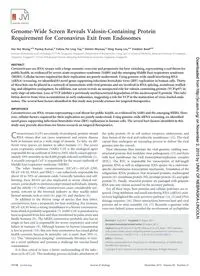
2015 Genome-Wide Screen Reveals Valosin-Containing Protein Requirement for Coronavirus Exit from Endosomes PDF
Preview 2015 Genome-Wide Screen Reveals Valosin-Containing Protein Requirement for Coronavirus Exit from Endosomes
Genome-Wide Screen Reveals Valosin-Containing Protein Requirement for Coronavirus Exit from Endosomes Hui Hui Wong,a,b Pankaj Kumar,a Felicia Pei Ling Tay,a Dimitri Moreau,a Ding Xiang Liu,a,c Frédéric Barda,b Institute of Molecular and Cell Biology/A*STAR, Singapore, Singaporea; Department of Biochemistry, Yong Loo Lin School of Medicine, National University of Singapore, Singapore, Singaporeb; School of Biological Sciences, Nanyang Technological University, Singapore, Singaporec ABSTRACT Coronaviruses are RNA viruses with a large zoonotic reservoir and propensity for host switching, representing a real threat for public health, as evidenced by severe acute respiratory syndrome (SARS) and the emerging Middle East respiratory syndrome (MERS). Cellular factors required for their replication are poorly understood. Using genome-wide small interfering RNA (siRNA) screening, we identified 83 novel genes supporting infectious bronchitis virus (IBV) replication in human cells. Thirty of these hits can be placed in a network of interactions with viral proteins and are involved in RNA splicing, membrane traffick- ing, and ubiquitin conjugation. In addition, our screen reveals an unexpected role for valosin-containing protein (VCP/p97) in early steps of infection. Loss of VCP inhibits a previously uncharacterized degradation of the nucleocapsid N protein. This inhi- bition derives from virus accumulation in early endosomes, suggesting a role for VCP in the maturation of virus-loaded endo- somes. The several host factors identified in this study may provide avenues for targeted therapeutics. IMPORTANCE Coronaviruses are RNA viruses representing a real threat for public health, as evidenced by SARS and the emerging MERS. How- ever, cellular factors required for their replication are poorly understood. Using genome-wide siRNA screening, we identified novel genes supporting infectious bronchitis virus (IBV) replication in human cells. The several host factors identified in this study may provide directions for future research on targeted therapeutics. C oronaviruses (CoV) are a family of enveloped, positive-strand RNA viruses that can cause respiratory and enteric disease both in humans and in a wide range of animals. To date, six dif- ferent virus species are known to affect humans (1). The severe acute respiratory syndrome (SARS) CoV is the etiological agent responsible for an outbreak in 2002 to 2003, which caused approx- imately 10% mortality in the 8,000 people infected worldwide (2). A recently emerged CoV is responsible for the recent outbreak of Middle East respiratory syndrome (MERS). The other human coronaviruses (HCoV)—HCoV-229E, HCoV-OC43, NL63, and HKU1—are collectively responsible for about 10 to 30% of common colds. Generally harmless and self- limiting, these HCoV are also implicated in severe clinical out- comes, particularly in immunocompromised individuals, infants, and the elderly (3). Other coronaviruses cause considerable eco- nomic concern to the livestock industry as they readily infect farmed animals such as cows (4), pigs (5), and chickens (6). In addition to the diverse range of species that they infect, coronaviruses have a propensity for host switching. For instance, HCoV-OC43 bears a strong resemblance to a bovine coronavirus, from which it probably originated (7). SARS-CoV is postulated to have originated from bats and then transferred to palm civets and finally humans (8). The MERS coronavirus probably also has its origin in bats and is responsible for severe respiratory and renal failure in humans (9). Although human-to-human transmission is low at present (10), this new beta-coronavirus has raised global health concerns because its mortality rate is more than 30% (1, 11). This “interspecies jumping” continuously threatens to initi- ate a novel epidemic and presents a challenge for vaccine-based containment. It is thus critical to have a better understanding of the infec- tious cycle of CoV. This multistep process includes attachment of the spike protein (S) to cell surface receptors, endocytosis, and then fusion of the viral and endocytic membranes (12). The viral capsid then undergoes an uncoating process to deliver the viral genome into the cytosol. Host ribosomes then translate the viral genome, yielding non- structural proteins that modulate virus pathogenesis (13) and form with host membranes the viral transcription/replication complex (RTC). The RTC is responsible for transcription of full-length genomic RNA as well as subgenomic RNA species via a nidovirus- specific discontinuous transcription mechanism. Translation of the subgenomic RNAs produces viral structural proteins, nucleocapsid protein (N), membrane protein (M), envelope protein (E), and spike protein (S). Finally, structural proteins are packaged with genomic RNA into new virions secreted via the secretory pathway. For all these steps, host proteins and cellular pathways are re- quired. Drug inhibition and small interfering RNA (siRNA) stud- ies have highlighted the early secretory pathway (14, 15) and DNA damage response (16). Direct interactions between host and viral proteins aid in virus assembly (16, 17). Recently, a genome-wide yeast two-hybrid screen revealed the involvement of cyclophilins Received 9 June 2015 Accepted 22 August 2015 Accepted manuscript posted online 26 August 2015 Citation Wong HH, Kumar P, Tay FPL, Moreau D, Liu DX, Bard F. 2015. Genome- wide screen reveals valosin-containing protein requirement for coronavirus exit from endosomes. J Virol 89:11116–11128. doi:10.1128/JVI.01360-15. Editor: S. Perlman Address correspondence to Ding Xiang Liu,
